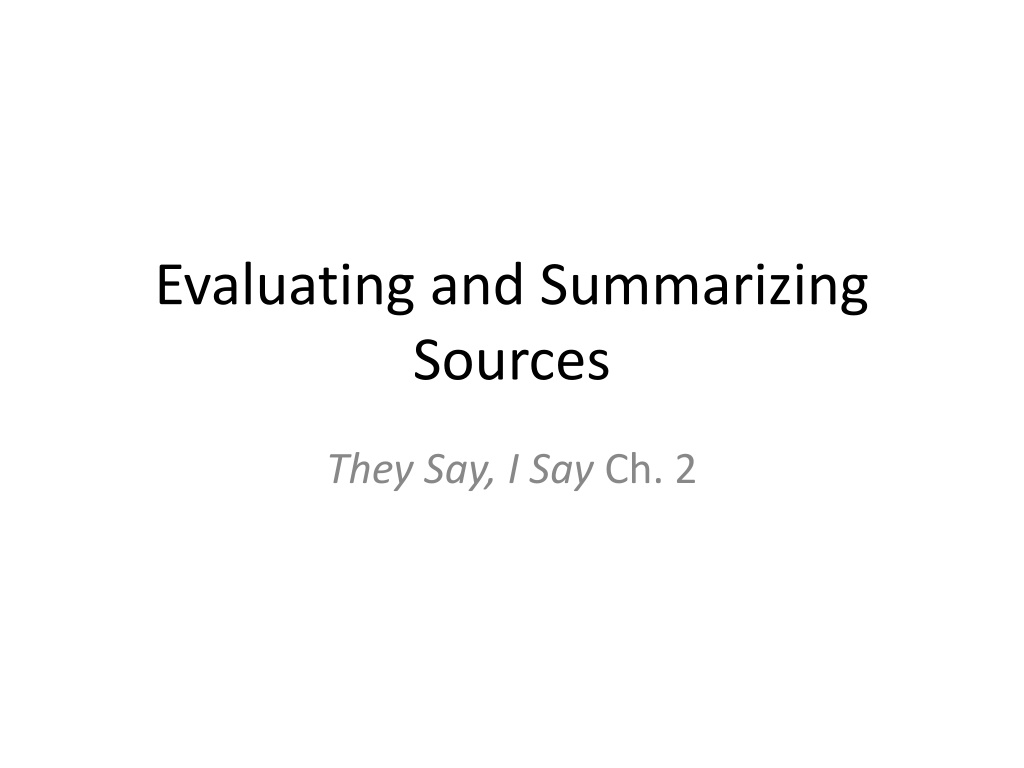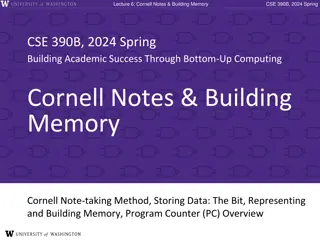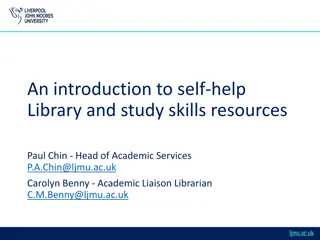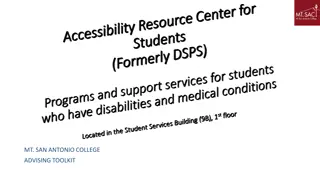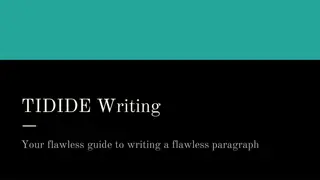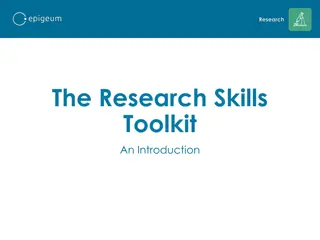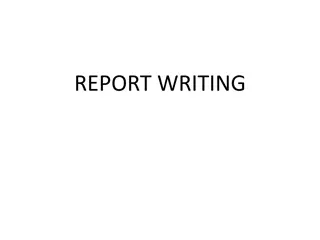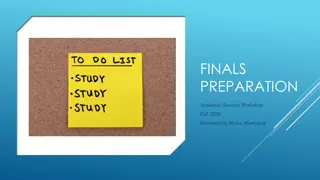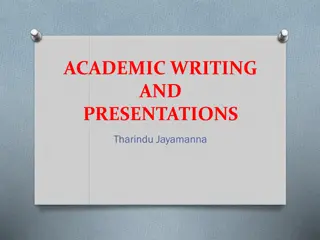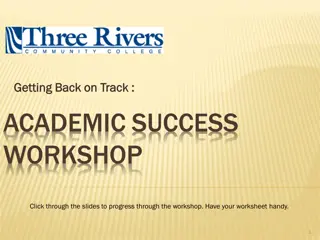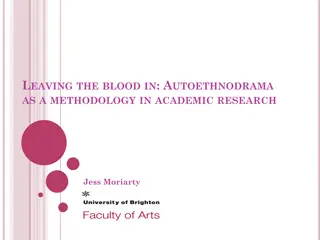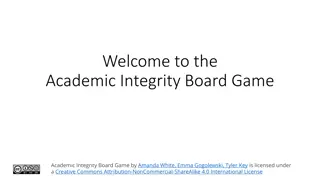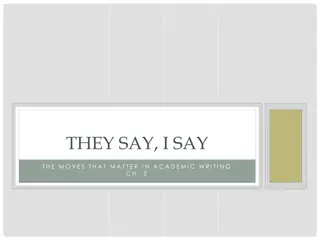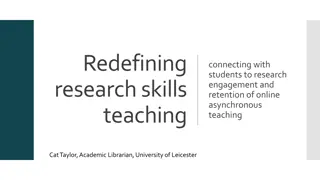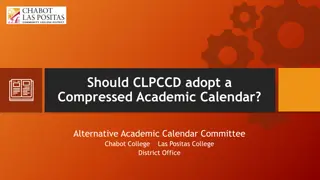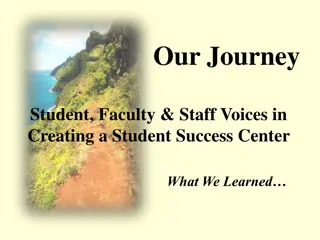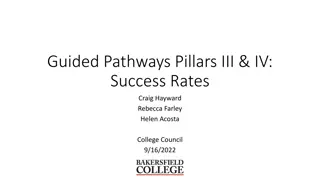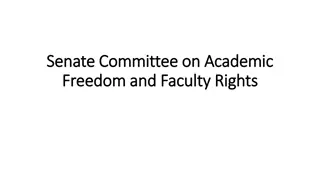Mastering Research Skills for Academic Success
Developing strong research skills is essential for academic success. This involves finding reliable sources, evaluating information, and integrating it effectively into your work. Utilize college databases, library resources, and online platforms to access a wide range of sources. Pay attention to search terms, key words, and suggestions from databases to refine your search results. Keep track of your sources and give proper credit using MLA format in your essays.
Download Presentation

Please find below an Image/Link to download the presentation.
The content on the website is provided AS IS for your information and personal use only. It may not be sold, licensed, or shared on other websites without obtaining consent from the author. Download presentation by click this link. If you encounter any issues during the download, it is possible that the publisher has removed the file from their server.
E N D
Presentation Transcript
Evaluating and Summarizing Sources They Say, I Say Ch. 2
Preparing for College Level Research Tell me about a time when you had to do research. This might be research you did for school, research into a product you were thinking of buying, research into how to apply for student aid, etc. What did you need to find out? Where did you go for information? How did you know which sources of information to trust?
There are Three Steps to Using Sources: Find sources and choose the best ones for your purpose. Read the sources carefully, keeping track of your own reactions to the author s ideas and using your sources as a springboard for your own contribution to the discussion. Use the sources in your essay, giving proper credit in the body of the essay and at the end, using MLA format.
Finding/Choosing Sources Why do you need to include sources in your essays? To show your audience that you are aware of the conversation that is already going on. To give your audience context for an argument you will make. To support a point you are making. To provide an example of an opposing point of view that you will then counter.
Where Can I Find Sources? College Databases (digital copies of sources) College Library (physical copies of sources) Public Library The Internet
Library Resources Library Databases can be accessed through the College Library website. Databases are collections of articles that have appeared, either in print or online, in various publications. Potentially useful databases: EBSCO (Academic Search Premiere) Academic OneFile Ethnic News Watch
Some Tips on Using the Databases If you don t get many results at first, try changing your search terms. Pay attention to the suggestions the databases make about related subjects. Pay attention to the key words your sources use, and do searches with those phrases. Make sure to check the full text search option so that you will be able to access any results you want. Email or save any results that interest you to read later. You may also print out articles here if you have a print card. Make sure that you keep a record of any sources you use from the databases.
Evaluating Online Sources Any sources you find through the databases are likely to be reputable sources, but what about typing your search terms into google or another search engine? This can be an excellent way to find resources that are very new and haven t been included in the databases yet, BUT there s a lot of junk out there. SO, how can you tell the junk from the good stuff?
Evaluating Online Sources Who takes responsibility for the piece of writing? Is it a print publication with an online presence? Is it an online-only publication with a history and/or a good reputation? Is it an organization with a good reputation? In what ways does the author establish credibility? Is the piece of writing presented well? (Are the points well argued/explained? Does the author display an awareness of the ongoing conversation? Does the piece of writing use clear grammar, spelling, and punctuation?)
Step 2: Read the Sources You Chose Read them all the way through. Unless you decide after the first paragraph that the source is not useful to you, how can you possibly respond to a source you ve only skimmed? Identify the author s big claims. Do you agree with them? If so, do you have anything to add to the author s support? If not, how would you counter the author s argument? Keep notes on your sources. Highlight. Write questions in the margins. Make connections between what one source says and another source says.
Step 2: Read the Sources You Chose A couple more things about sources Just because you find a source and read it doesn t mean you have to use it. If you read a source and don t like it, keep looking. Keep researching throughout the writing process. If you find a wonderful source with all kinds of good ideas you want to respond to after you wrote a draft, that s fine. Include that source and your response when you revise. Keep track of every source you use ideas or quotes from in your paper. You will need to be able to find the source again when you give it credit.
What does this mean for OUR Essay #1 specifically? Right now you need to be reading everything you can find about your specific topic relating to diversity and the media. For each source, ask yourself: Why is this source credible? What makes the author/organization believable? Why would ideas/quotes from this source be a useful addition to your paper? Read general articles about pop culture and diversity to start out if you would like, but you need to be reading articles that address your narrowed topic as well.
Step 3: Using Sources and Giving Credit You ve found your sources, read them, annotated them, and you re ready to use your sources in your essay. So which quotes should you use? Quotes that contain ideas you want to respond to. Quotes where the original source s wording is especially good or important to your response. Quotes where the original source explains a complex idea clearly and succinctly. Quotes that contain ideas that would make most people want proof. Any quote you use should have an explanation/response that is TWICE AS LONG as the original quote. If a quote takes up two full lines of your paper, the explanation/response to that quote should take up FOUR.
Review ofThey Say, I Say Ch. 2 1. What is the purpose of summarizing others material in your own writing? Fairly represent what an author says. Prepare for your own response (focus on points that will be important for you). 2. How can you avoid a list summary? (And why do you need to do this?) 1. Summarize with regard to your own interests. 2. Avoid says or discusses to describe your sources points, using more interesting and accurate words instead.
Summarizing In Essay #1 In your first essay, you may find yourself summarizing an entire essay we read in class or a whole source you found yourself in a few lines. Make sure that after you summarize, you give credit. Example: According to the article TV Diversity: Whose Job is it Anyway? The people involved in making movies offer many reasons that there are fewer African Americans than one would expect being cast in mainstream roles. Many of these reasons, though, do not hold up to scrutiny (Walden). These weak excuses suggest that while we have made many advances towards racial equality, there is still work to be done.
Practice Summarizing with Previous Essays So far, we have read the following essays: Pop Culture: An Overview (posted online) "Mickey Mouse as an Icon: Taking Pop Culture Seriously" on p. 5-9 Do I Look Like Public Enemy Number One?" p. 45-49 "TV Diversity: Whose Job is it, Anyway? (posted online) Your task is to write a summary of one of these articles using the strategies in Chapter 2 of They Say, I Say. (See example on p. 34-35) 1stparagraph should SUMMARIZE the source, making sure to summarize in your own words and give credit in MLA format when you finish summarizing. Your summary should also prepare for your response. (This means the issues you focus on in your 2ndparagraph should receive a lot of attention in your first.) 2ndparagraph should respond to the source, using the summary as a springboard for discussion of your reactions/ideas. Any further paragraphs should continue to respond to the ideas summarized in the 1stparagraph.
